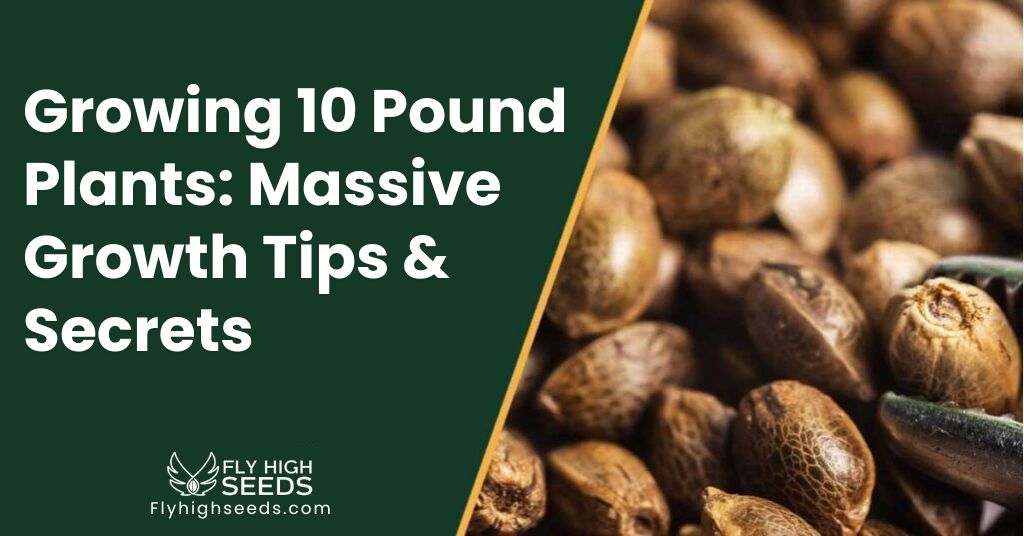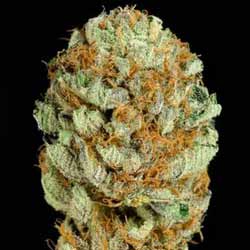
Growing 10 Pound Plants: Massive Growth Tips & Secrets
Achieving the impressive goal of growing 10-pound cannabis plants demands a combination of expertise, dedication, and careful cultivation practices. This pursuit involves pushing the boundaries of plant growth to produce exceptionally large yields. In “Growing 10 Pound Plants: Massive Growth Tips & Secrets,” we delve into the insights, techniques, and strategies employed by experienced cultivators to attain such remarkable results. From optimizing nutrients and light to managing space and genetics, this guide unveils the secrets behind achieving massive cannabis growth and offers valuable advice for those seeking to maximize their cultivation prowess.
Table of Contents
What Is The Average Weight Of Dry Flower From One Cannabis Plant?
The average weight of dry flower from one cannabis plant can vary widely depending on several factors, including the strain, growing conditions, cultivation techniques, genetics, and the expertise of the grower. However, as a rough estimate, a well-cultivated cannabis plant can yield anywhere from 1 to 3 ounces (28 to 85 grams) of dried flower on average. Some experienced growers might achieve higher yields, especially when employing advanced cultivation methods.
It’s important to note that these figures are general estimates, and actual yields can be influenced by various factors, including the size of the plant, the length of the vegetative and flowering phases, light intensity, nutrient regimen, and overall care. Additionally, some strains are inherently higher-yielding than others.
What Factors Determine The Weight From Cannabis Plants?
The weight of cannabis plants, specifically the yield of dried flower, is influenced by a multitude of factors that interact to determine the final outcome. Here are some of the key factors that play a role in determining the weight from cannabis plants:
- Genetics: The genetics of the cannabis strain you’re growing have a significant impact on potential yield. Some strains are naturally higher-yielding than others due to their genetic makeup.
- Growing Medium: The type of growing medium you use (soil, hydroponics, coco coir, etc.) affects nutrient availability, root development, and overall plant health, which in turn influences yield.
- Nutrient Management: Providing the right balance of nutrients, including nitrogen, phosphorus, and potassium, is crucial for optimal plant growth and flower production.
- Lighting: The quality, intensity, and spectrum of light provided to the plants significantly impact their growth and yield. High-quality lighting systems, whether natural sunlight or artificial grow lights, are essential.
- Light Cycle: Maintaining the correct light cycle during the vegetative and flowering stages is crucial. The standard 18/6 (light/dark) for vegetative and 12/12 for flowering are common light cycles, but slight variations can also affect yield.
- Temperature and Humidity: Maintaining the appropriate temperature and humidity levels throughout the growth cycle ensures healthy growth and flower development.
- Air Circulation and Ventilation: Proper air circulation prevents heat and humidity buildup, promotes strong stems, and prevents mold or pest issues that can impact yield.
- Training Techniques: Techniques like topping, pruning, and Low-Stress Training (LST) can optimize light penetration and encourage the growth of multiple colas, increasing yield.
- Growing Space: The size of the growing space, including both vertical and horizontal space, determines how much each plant can expand and produce.
- Plant Health and Pest Management: Healthy plants are more likely to produce larger yields. Proper pest management and disease prevention are essential to maintaining plant health.
- Harvest Timing: Harvesting at the optimal time, when trichomes are mature and cannabinoids are potent, can influence the overall quality and yield of the flower.
- Experience: Growers with experience and knowledge of cannabis cultivation techniques are better equipped to manage the various factors that impact yield.
Is It Possible To Grow 10 Pounds Of Dry Flower From One Plant?
Several factors would need to align for such a high yield:
- Strain: You would need to grow a strain that is renowned for its high yield potential. Even then, genetics alone might not guarantee such a massive yield.
- Growing Conditions: The growing environment would need to be absolutely optimized with precise control over lighting, nutrients, temperature, humidity, air circulation, and other variables.
- Advanced Techniques: Implementing advanced cultivation techniques like ScrOG (Screen of Green), hydroponics, supplemental CO2, and meticulous training methods could contribute to maximizing yield.
- Experienced Grower: Achieving such a high yield would likely require the expertise of an experienced cannabis cultivator who has mastered the art of plant care and optimization.
- Space: You would need ample space to accommodate a plant with the potential to produce 10 pounds of dried flower.
- Luck: Despite all efforts, there is still an element of luck involved in achieving exceptional yields, as there are variables that may not be entirely controllable.
Keep in mind that the vast majority of cannabis plants produce yields that are far lower than 10 pounds of dried flower. Most cultivators consider yields of a few ounces to a pound of dried flower per plant to be successful. While aiming for high yields is admirable, it’s important to set realistic expectations and focus on quality cultivation practices rather than solely chasing extreme numbers.
How Many Grams Or Ounces Are In A Pound Of Cannabis?
There are approximately 448 grams in a pound of cannabis. In terms of ounces, there are 16 ounces in a pound. So, a pound of cannabis would be equivalent to either 448 grams or 16 ounces. This is a standard conversion used in various industries, including the cannabis industry, for measuring quantities of various substances, including dried cannabis flower.
How Big Can Cannabis Plants Grow?
The size to which cannabis plants can grow varies widely based on several factors, including the strain, genetics, growing conditions, and cultivation practices. Cannabis plants have the ability to grow to varying heights and widths, ranging from a few inches to over 15 feet (4.5 meters). Here are some general guidelines for the potential size of cannabis plants:
- Indoor Growth: Indoor cannabis plants are typically smaller due to space limitations and the controlled environment. Most indoor plants are trained to stay within a manageable height, usually between 1 to 4 feet (30 to 120 centimeters), depending on the strain and training techniques used.
- Outdoor Growth: Outdoor cannabis plants have the potential to grow larger due to access to natural sunlight and unrestricted root space. Some outdoor plants can reach heights of 10 to 15 feet (3 to 4.5 meters) or even more, especially when grown in climates with long growing seasons.
- Sativa vs. Indica: Sativa-dominant strains tend to grow taller and have more elongated leaves, while indica-dominant strains are generally more compact and bushy.
- Growing Techniques: Techniques like topping, pruning, and training (such as Low-Stress Training or ScrOG) can influence the shape and size of cannabis plants. These techniques are used to control height, increase light penetration, and encourage lateral growth.
- Genetics: Genetics play a significant role in determining how tall a cannabis plant can grow. Some strains are naturally more compact, while others have a tendency to stretch and reach taller heights.
- Vegetative Stage: The duration of the vegetative growth phase also affects the size of the plant. Longer vegetative periods can lead to larger plants.
What Produces More Flower Indicas Or Sativias?
The amount of flower produced by indica and sativa cannabis plants can vary based on genetics, growing conditions, and cultivation techniques. Generally, there is no strict rule that indica or sativa plants inherently produce more flowers. The potential flower yield depends on several factors:
- Strain Genetics: The genetics of a specific strain play a significant role in determining its yield. Some strains, whether indica, sativa, or hybrid, are bred to be high-yielding in terms of flower production.
- Cultivation Techniques: The techniques used to cultivate cannabis, such as nutrient management, lighting, pruning, and training, can greatly influence flower production. Proper techniques can maximize yield for both indica and sativa plants.
- Growing Conditions: Providing the right environment, including temperature, humidity, air circulation, and CO2 levels, supports healthy growth and optimal flower production.
- Duration of Vegetative Stage: The length of the vegetative growth phase impacts the overall size of the plant and the potential for flower development.
- Size and Space: The available space for each plant can affect how much they can grow and produce. Larger plants generally have more potential for flower production.
- Growing Medium: The type of growing medium (soil, hydroponics, coco coir, etc.) can affect nutrient availability and overall plant health.
- Experience: Growers with more experience are likely to optimize their techniques over time, leading to better yields regardless of strain type.
Growing 10 Pound Plants: How To Grow Massive Cannabis Trees
Growing massive cannabis plants with the potential to yield 10 pounds or more of dried flower is an ambitious endeavor that requires advanced cultivation techniques and careful planning. Here’s a concise guide on how to cultivate such impressive cannabis trees:
- Strain Selection: Choose high-yielding strains known for producing substantial flower harvests. Look for genetics with a track record of large yields.
- Growing Space: Provide ample space for each plant to spread out. Outdoor gardens or spacious indoor setups are essential for accommodating the size of the plants.
- Vegetative Stage: Extend the vegetative growth phase to allow plants to develop robust root systems and large foliage. Longer veg periods promote bigger plants.
- Training Techniques: Employ techniques like topping, super cropping, and Low-Stress Training (LST) to encourage lateral growth and multiple colas. This helps optimize light distribution.
- Screen of Green (ScrOG): Utilize a ScrOG net to spread out the canopy and ensure all bud sites receive adequate light, resulting in a more even yield.
- Supplemental Lighting: Implement powerful grow lights to provide intense light coverage, stimulating vigorous growth and bud development.
- Nutrient Management: Provide a balanced nutrient regimen tailored to each growth phase, ensuring plants receive essential macronutrients and micronutrients.
- Optimal Environment: Maintain precise temperature, humidity, and CO2 levels to promote healthy growth and prevent stress-related issues.
- Pruning: Regularly remove large fan leaves that block light penetration to lower parts of the plant. This redirects energy to developing bud sites.
- Support Structures: As plants grow heavy with flowers, use stakes or trellises to support branches and prevent breakage.
- Pest and Disease Prevention: Implement strict pest management practices to ensure plants remain healthy and unharmed by infestations.
- Patience: Understand that growing such massive plants requires time and dedication. Monitor their progress and make adjustments as needed.
- Harvest Timing: Harvest plants when trichomes are mature and the buds are at their peak potency. This ensures the highest quality final product.
- Experience and Learning: Continuously educate yourself about advanced cultivation techniques and learn from each growing cycle to refine your approach.
Choose The Right Genetics
Choosing the right genetics for your cannabis cultivation is a critical decision that can significantly impact the outcome of your grow. To make an informed choice, consider factors such as the strain type (indica, sativa, hybrid), potential yield, Cannabinoid and CBD levels, flavor and aroma preferences, growth characteristics, climate suitability, your level of growing experience, disease resistance, breeder reputation, reviews from other growers, and your cultivation purpose (personal use, medicinal, or commercial). Research reputable breeders and sources to ensure you’re obtaining high-quality and stable genetics. Ultimately, the right genetics should align with your goals, preferences, and growing conditions, setting the stage for a successful and satisfying cultivation journey.
Light Type, Strength, & Footprint
Selecting the appropriate light type, strength, and footprint is essential for successful cannabis cultivation. When growing indoors, LED lights are often preferred due to their efficiency and customizable spectrum. High-Intensity Discharge (HID) lights like Metal Halide (MH) for vegetative growth and High-Pressure Sodium (HPS) for flowering are also popular options. Fluorescent lights work well for seedlings and small spaces. For optimal results, aim for around 30-50 watts per square foot during the vegetative stage and 50-75 watts per square foot during flowering. Adjust the light’s hanging height as plants grow to maintain an even light distribution and avoid light burn.
When cultivating outdoors, harnessing the power of natural sunlight is key. Ensure your growing area receives a minimum of 6-8 hours of direct sunlight daily for healthy growth. Understanding the different light spectrum needs during the vegetative and flowering stages is crucial. Provide higher Kelvin temperatures (4000K-6500K) with more blue spectrum light during vegetative growth and lower Kelvin temperatures (2700K-3500K) with red and orange spectrum light during the flowering stage. Consider the specific requirements of your chosen strain and cultivation goals to tailor your light setup accordingly, and stay informed about the latest advancements in light technologies to optimize your cannabis cultivation journey.
Grow Space
The choice of grow space is a fundamental aspect of successful cannabis cultivation. Whether indoors or outdoors, the grow space directly impacts plant health, yield, and overall cultivation experience. Indoor growers have the advantage of complete environmental control, allowing them to tailor lighting, temperature, humidity, and air circulation to the plants’ needs. This flexibility empowers cultivators to maximize growth potential and customize conditions for different growth stages. Selecting the right size and layout of the indoor space is crucial for accommodating plant size, number, and cultivation equipment. It’s essential to ensure proper ventilation and air exchange to prevent mold and optimize CO2 levels for vigorous growth.
For outdoor growers, the natural environment plays a significant role. The chosen location should receive ample sunlight, preferably 6-8 hours of direct sunlight daily. Adequate space between plants is crucial to allow for air circulation, reduce the risk of disease, and prevent shading. Consider factors like wind patterns, potential pests, and privacy when selecting an outdoor grow site. Ultimately, both indoor and outdoor growers must evaluate their available space, resources, and goals to create an optimal environment that fosters healthy cannabis growth and maximizes yield potential.
Temperature
Temperature control is a critical factor in successful cannabis cultivation, as it profoundly influences plant growth, development, and overall health. During the vegetative stage, maintaining temperatures between 70°F to 85°F (21°C to 29°C) promotes vigorous growth and healthy root systems. As the plants transition to the flowering stage, slightly cooler temperatures around 65°F to 80°F (18°C to 27°C) help optimize resin production and bud development. Extreme temperature fluctuations can stress the plants and hinder growth, making consistency vital. Proper temperature management, along with suitable humidity levels and proper ventilation, creates an optimal environment that supports robust cannabis growth and leads to high-quality yields.
Humidity Levels
Maintaining the right humidity levels is paramount for successful cannabis cultivation. During the vegetative stage, aim for humidity between 40% to 70% to prevent dehydration and encourage healthy leafy growth. As plants enter the flowering phase, gradually decrease humidity to around 40% to 50% to discourage mold and mildew growth on dense buds. Excessive humidity can lead to pest infestations and fungal issues, while low humidity can stress the plants and slow growth. Monitoring and controlling humidity, along with proper temperature and ventilation management, ensures an ideal environment that fosters vigorous cannabis growth and ultimately results in robust, resinous buds with exceptional quality.
Nutrients
Providing the right nutrients is a fundamental aspect of successful cannabis cultivation. Cannabis requires a balanced diet of macronutrients (nitrogen, phosphorus, potassium) and micronutrients (iron, zinc, magnesium, etc.) to thrive. During the vegetative stage, higher nitrogen levels promote lush growth, while phosphorus and potassium become more important during flowering to support bud development. Nutrient deficiencies or excesses can manifest as stunted growth, yellowing leaves, or poor flower formation. It’s crucial to choose a suitable nutrient formula designed for cannabis cultivation and closely monitor pH levels to ensure optimal nutrient uptake. Tailoring nutrient concentrations to each growth stage and adjusting as needed helps maintain healthy plants and maximizes the potential for robust yields of high-quality cannabis.
Watering/Moisture
Proper watering and moisture management are essential for cultivating healthy cannabis plants. Overwatering can lead to root rot and other fungal issues, while underwatering can cause stress and hinder growth. The “wet-dry” cycle is crucial: allow the top inch or two of the soil to dry out before watering again. Use your fingers or a moisture meter to assess soil moisture levels. Additionally, maintaining proper drainage in pots prevents water accumulation around the roots. It’s important to note that moisture needs vary throughout the plant’s lifecycle. During the vegetative stage, when plants are growing rapidly, they may need more frequent watering, whereas in the flowering stage, reduced watering can encourage bud development and prevent mold in dense flowers. Mastering the art of balanced watering and moisture control is key to cultivating strong, resilient cannabis plants with optimal growth and yields.
Training Techniques
Training techniques are vital tools for shaping the growth of cannabis plants to maximize yields and optimize light distribution. Low-Stress Training (LST), for instance, involves gently bending and securing branches to encourage lateral growth and create an even canopy. High-Stress Training (HST) methods, like topping or fimming, involve strategically removing or damaging the main stem to promote the growth of multiple colas. The Screen of Green (ScrOG) technique employs a screen to train plants horizontally, ensuring all bud sites receive ample light. Supercropping involves carefully bending stems to increase light exposure and enhance nutrient distribution. By employing these techniques, cultivators can tailor their plants’ growth patterns, increase bud development, and enhance overall health. Proper training methods combined with attentive care contribute to healthier and more productive cannabis plants, ultimately yielding higher-quality buds.
Pest Control
Effective pest control is paramount for maintaining the health and vitality of cannabis plants throughout their growth cycle. Preventing and managing pests involves a multi-pronged approach. Regular monitoring of plants for early signs of infestations, such as discoloration, wilting, or unusual growth patterns, allows for swift action. Implementing cultural practices like maintaining proper spacing between plants, ensuring proper air circulation, and regularly cleaning the growing area can deter pests and reduce their impact. Natural predators, such as beneficial insects like ladybugs or predatory mites, can be introduced to help control pest populations in an eco-friendly manner.
In cases where infestations become severe, organic or chemical treatments may be necessary. Utilizing approved pesticides specifically designed for cannabis, while adhering to safety guidelines, can help combat pests effectively. However, it’s essential to strike a balance between pest control and maintaining the overall health of the plants, as some treatments can affect beneficial organisms and plant health. Vigilance, early intervention, and a well-rounded approach to pest management contribute to a thriving cannabis garden that’s resistant to pests and conducive to high-quality yields.
Mold Control
Controlling mold is a critical aspect of successful cannabis cultivation to ensure the quality and safety of the final product. Proper ventilation, maintaining appropriate humidity levels, and spacing plants adequately to promote air circulation are essential preventive measures. Regularly inspecting plants for signs of mold, such as fuzzy growth or discoloration, allows for early intervention. Should mold appear, immediate action is crucial – isolate affected plants, improve ventilation, and consider using organic fungicides. By prioritizing mold prevention and swift response, cultivators can safeguard their cannabis crops from the detrimental effects of mold, ensuring healthy plants and desirable yields.
Start Initial Growth Indoors Then Move Cannabis Plants Outdoors
Starting cannabis plants indoors before transitioning them outdoors can provide several advantages for successful cultivation. Indoors, controlled conditions allow for careful monitoring of seedling development and establishment of robust root systems. This approach enables growers to protect young plants from adverse weather, pests, and diseases. Once plants have gained strength and size, the gradual transition outdoors exposes them to natural sunlight, promoting healthy photosynthesis and acclimatization to outdoor conditions. This method maximizes plant resilience and enhances overall growth potential, resulting in strong, thriving cannabis plants ready to flourish in an outdoor environment.
Incorporate CO2 For Larger & Denser Buds
Incorporating carbon dioxide (CO2) enrichment into the cannabis cultivation process can have a significant impact on bud size and density. CO2 is an essential element in photosynthesis, the process through which plants convert light energy into sugars, which fuels growth. By elevating CO2 levels in the grow environment, plants can potentially accelerate their metabolic processes, leading to enhanced nutrient uptake and larger, denser buds. However, it’s important to strike a balance; too much CO2 can stress plants and potentially harm their growth. Careful monitoring, coupled with appropriate ventilation and proper nutrient management, can create an environment where cannabis plants thrive with increased CO2 levels, ultimately contributing to the development of more substantial and higher-quality buds.
Horizontal Stalk Growth Technique
The Horizontal Stalk Growth Technique is a training method employed in cannabis cultivation to maximize light exposure and promote even bud development. By gently bending the main stem or branches horizontally, growers encourage lateral growth and the creation of multiple canopy levels. This technique helps ensure that all bud sites receive ample light, resulting in more uniform and robust flower production. Properly executed, the Horizontal Stalk Growth Technique optimizes plant architecture, enhances light penetration, and ultimately contributes to higher yields of quality cannabis buds.
Related Posts
Best Seed Banks This 2025: Top 5 Choices for Cultivators
Seed Banks in the United States: 5 Top Selections of 2025
The Top 5 Reputable Seed Banks in the USA for Cannabis Cultivators
CATEGORIES
Best Selling Seeds












